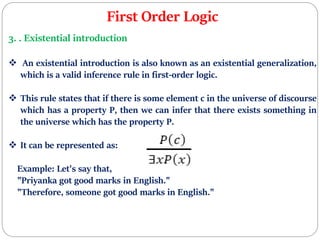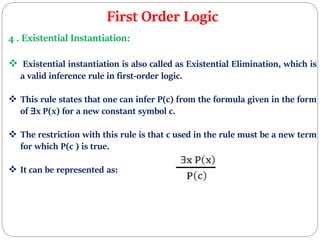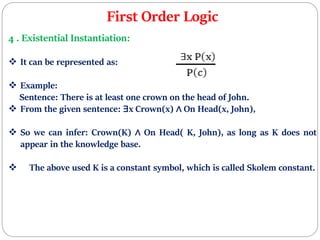Ai lecture 10(unit03)
- 1. Topic To Be Covered: First Order Logic(Part-02) Jagdamba Education Society's SND College of Engineering & Research Centre Department of Computer Engineering SUBJECT: Artificial Intelligence & Robotics Lecture No-10(UNIT-03) Logic & Reasoning Prof.Dhakane Vikas N
- 3. First Order Logic Inference in First-Order Logic ’üČ Inference in First-Order Logic is used to deduce new facts or sentences from existing sentences. ’üČ understanding the FOL inference rule, let's understand some basic terminologies used in FOL. I. Substitution: ’üČ Substitution is a fundamental operation performed on terms and formulas. ’üČ It occurs in all inference systems in first-order logic. ’üČ The substitution is complex in the presence of quantifiers in FOL. ’üČ If we write F[a/x], so it refers to substitute a constant "a" in place of variable "x".
- 4. First Order Logic Inference in First-Order Logic II. Equality: ’üČ First-Order logic does not only use predicate and terms for making atomic sentences but also uses another way, which is equality in FOL. ’üČ For this, we can use equality symbols which specify that the two terms refer to the same object. Example: Brother (John) = Smith. ’üČ As in the above example, the object referred by the Brother (John) is similar to the object referred by Smith. ’üČ The equality symbol can also be used with negation to represent that two terms are not the same objects. Example: ’┐ó(x=y) which is equivalent to x ŌēĀy.
- 5. First Order Logic FOL inference rules for quantifier: As propositional logic we also have inference rules in first-order logic, so following are some basic inference rules in FOL: 1. Universal Generalization 2. Universal Instantiation 3. Existential introduction 4. Existential Instantiation
- 6. First Order Logic FOL inference rules for quantifier: 1. Universal Generalization: ’üČ Universal generalization is a valid inference rule which states that if premise P(c) is true for any arbitrary element c in the universe of discourse, then we can have a conclusion as ŌłĆ x P(x). ’üČ It can be represented as: ’üČ This rule can be used if we want to show that every element has a similar property. ’üČ In this rule, x must not appear as a free variable. ’üČ Example: Let's represent, P(c): "A byte contains 8 bits", so for ŌłĆ x P(x) "All bytes contain 8 bits.", it will also be true.
- 7. First Order Logic 2. Universal Instantiation: ’üČ Universal instantiation is also called as universal elimination or UI is a valid inference rule. ’üČ As per UI, we can infer any sentence obtained by substituting a ground term for the variable. ’üČ The UI rule state that we can infer any sentence P(c) by substituting a ground term c (a constant within domain x) from ŌłĆ x P(x) for any object in the universe of discourse. ’üČ It can be represented as: Example:1. IF "Every person like ice-cream"=> ŌłĆx P(x) so we can infer that ŌłĆx:person(x) ->Likes(x,icecream) So from this information, we can infer following statements using Universal Instantiation: person(john) ->Likes(john,icecream)
- 8. First Order Logic 2. Universal Instantiation: ’üČ It can be represented as: Example:2 Let's take a famous example, "All kings who are greedy are Evil." So let our knowledge base contains this detail as in the form of FOL: ŌłĆx king(x) Ōł¦ greedy (x) ŌåÆ Evil (x), So from this information, we can infer any of the following statements using Universal Instantiation: King(John) Ōł¦ Greedy (John) ŌåÆ Evil (John), King(Richard) Ōł¦ Greedy (Richard) ŌåÆ Evil (Richard),
- 9. First Order Logic 3. . Existential introduction ’üČ An existential introduction is also known as an existential generalization, which is a valid inference rule in first-order logic. ’üČ This rule states that if there is some element c in the universe of discourse which has a property P, then we can infer that there exists something in the universe which has the property P. ’üČ It can be represented as: Example: Let's say that, "Priyanka got good marks in English." "Therefore, someone got good marks in English."
- 10. First Order Logic 4 . Existential Instantiation: ’üČ Existential instantiation is also called as Existential Elimination, which is a valid inference rule in first-order logic. ’üČ This rule states that one can infer P(c) from the formula given in the form of Ōłāx P(x) for a new constant symbol c. ’üČ The restriction with this rule is that c used in the rule must be a new term for which P(c ) is true. ’üČ It can be represented as:
- 11. First Order Logic 4 . Existential Instantiation: ’üČ It can be represented as: ’üČ Example: Sentence: There is at least one crown on the head of John. ’üČ From the given sentence: Ōłāx Crown(x) Ōł¦ On Head(x, John), ’üČ So we can infer: Crown(K) Ōł¦ On Head( K, John), as long as K does not appear in the knowledge base. ’üČ The above used K is a constant symbol, which is called Skolem constant.

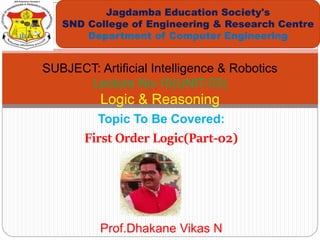
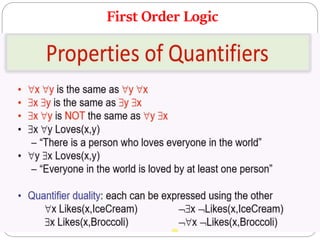
![First Order Logic
Inference in First-Order Logic
’üČ Inference in First-Order Logic is used to deduce new facts or sentences
from existing sentences.
’üČ understanding the FOL inference rule, let's understand some basic
terminologies used in FOL.
I. Substitution:
’üČ Substitution is a fundamental operation performed on terms and
formulas.
’üČ It occurs in all inference systems in first-order logic.
’üČ The substitution is complex in the presence of quantifiers in FOL.
’üČ If we write F[a/x], so it refers to substitute a constant "a" in place of
variable "x".](https://image.slidesharecdn.com/ailecture-10unit03-210506093118-f0ce1b/85/Ai-lecture-10-unit03-3-320.jpg)





